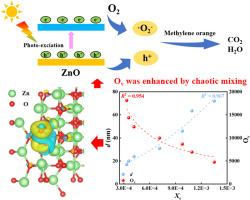Unveiling the role of mixing enhancement in oxygen vacancy concentration and particle size during high-throughput synthesis of ZnO photocatalyst in a microreactor
IF 3.9
3区 工程技术
Q3 ENERGY & FUELS
Chemical Engineering and Processing - Process Intensification
Pub Date : 2025-08-23
DOI:10.1016/j.cep.2025.110518
引用次数: 0
Abstract
Oxygen vacancy (Ov) concentration and particle size (d) are critical to the performance of metal oxide photocatalysts. Here, taking advantage of strong chaotic mixing performance in a four-stage oscillating feedback microreactor (FOFM), the ZnO with small d and high Ov concentration were controllably prepared. First, dye-tracer experiments and Villermaux-Dushman reactions were used to investigate the macroscopic and micromixing performance within FOFM. Then, ZnO was prepared using FOFM at different flow rates, and the role of mixing enhancement in d and Ov concentration of ZnO was unveiled. The results indicate that increasing flow rates would enhance chaos intensity of fluids, thereby obtaining products with smaller d and higher Ov concentration. Photocatalytic tests indicate that ZnO prepared with small d has excellent photocatalytic performance for methyl orange degradation. DFT calculations prove that Ov can reduce adsorption energy of ZnO-*O2 and enhance bonding strength between Zn and *O, thereby promoting adsorption of O2.

揭示了混合增强在微反应器高通量合成ZnO光催化剂过程中对氧空位浓度和粒径的影响
氧空位浓度(Ov)和粒径(d)是影响金属氧化物光催化剂性能的关键因素。利用四级振荡反馈微反应器(FOFM)的强混沌混合性能,可控地制备了具有小d和高Ov浓度的ZnO。首先,采用染料示踪实验和Villermaux-Dushman反应研究了FOFM的宏观和微观混合性能。然后,用FOFM在不同流速下制备ZnO,揭示了ZnO在d和Ov浓度下的混合增强作用。结果表明,增大流量会增强流体的混沌强度,从而得到d较小、Ov浓度较高的产物。光催化实验表明,用小d制备的ZnO对甲基橙具有良好的光催化性能。DFT计算证明Ov可以降低ZnO-*O2的吸附能,增强Zn与*O之间的键合强度,从而促进对O2的吸附。
本文章由计算机程序翻译,如有差异,请以英文原文为准。
求助全文
约1分钟内获得全文
求助全文
来源期刊
CiteScore
7.80
自引率
9.30%
发文量
408
审稿时长
49 days
期刊介绍:
Chemical Engineering and Processing: Process Intensification is intended for practicing researchers in industry and academia, working in the field of Process Engineering and related to the subject of Process Intensification.Articles published in the Journal demonstrate how novel discoveries, developments and theories in the field of Process Engineering and in particular Process Intensification may be used for analysis and design of innovative equipment and processing methods with substantially improved sustainability, efficiency and environmental performance.

 求助内容:
求助内容: 应助结果提醒方式:
应助结果提醒方式:


